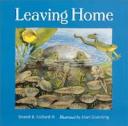Leaving Home, written by Sneed B. Collard III and illustrated by Joan Dunning, is an endearing book that takes students on a journey around the world to visit a variety of habitats and learn about some of the animals found in them.
From the sea to the jungle, from the forest to the desert, students will begin to build insight on why the physical and behavioral adaptations animals have are necessary for survival in their given environment. A page is dedicated for each animal discussed and provides information on the animals general life cycle from birth through adulthood. Each page begins with how the animal simply moves about, providing a simplisitic yet effective way to show the many means in which animals travel; for example, on the shark page, it says, “some of us swim,” while on the jaguar page it says, “some of us walk.”
The author also presents the behavioral and physical adaptations specific to each animal, such as if babies resemble their parents upon birth, how they gather or store found, where they make their shelter, how they rear their young (laying eggs versus giving birth, providing milk or not), and if hibernation, migration, camouflage, instinct, and learned behaviors are aspects to their species. The illustrations are superb and enticing to view by offering great detail that clearly allow students to see how the animal’s physical adaptations coincide with their surroundings.
The writing flows easily and offers students a concise yet vast amount of information needed in order to further explore these adaptations in more detail. This book can surely serve as an effective anticipatory resource prior to a unit on animal life cycles and adaptations or as a tool for review prior to testing. The author will leave students knowing so much more about these animals and instill a desire to want to learn even more about them.
Curriculum Connections
Leaving Home serves as an appropriate and useful resource to help teach, reinforce, and emphasize specific second and third grade science life processes objectives in accordance with the Virginia Standards of Learning (SOL’s). Investigating and understanding that animals undergo a series of orderly changes in their life cycle (SOL 2.4) is supported throughout the entire book due to the wide spectrum of animals discussed, including invertebrates, vertebrates, reptiles, amphibians, mammals, birds, and insects. Also, the author discusses the distinct stages during each animal’s life and how they can vary from one animal to another (SOL 2.4a). The behavioral and physical adaptations necessary for an animal’s survival (SOL 3.4), such as methods of gathering and storing food, finding shelter, rearing young (SOL 3.4a), migration, instinct, and learned behavior (SOL 3.4b) are explained in explicit detail for each animal discussed.
Additional Resources
-
Mrs. Becky Wick , a current second grade teacher from Missouri, has designed an absolutely amazing website that offers almost everything you and your students will need in order to thoroughly investigate and explore animal life cycles, including activity and project ideas, interactive online games, and lesson plans! This site is a must to visit!
-
The Teacher’s Guide website has dedicated an outstanding page full of lesson plans, printables, and project suggestions dedicated to the frog. If your looking for any resources to supplement your teaching on this amphibian’s life cycle, including metamorphosis as part of their of physical development, and/or behavioral adaptations, you will not need to look any further than here!
-
TeacherVision offers a wide proposal of lesson plans, activities, and projects on animal adaptations, covering the aspects of migratation, hibernation, mimicry, and learned behaviors specific to each animal. This site also offers all of these resources for different grade levels, so you are certain to find something that fit’s each of your student’s needs!
Book: Leaving Home
Author: Sneed B. Collard III
Illustrator: Joan Dunning
Publisher: Houghton Mifflin Harcourt
Publication Date: March 2002
Pages: 32pp
Grade Range: 2nd and 3rd Grade
ISBN-13: 9780618114542

